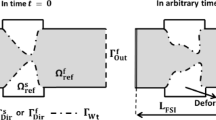Abstract
Numerical modeling of harmonic acoustic field produced by a common commercial loudspeaker is carried out. The goal is to obtain the directional characteristic of the device. So far, these characteristics could only be obtained by measurements, which was very complicated and also expensive. Another benefit of the model consists in obtaining a reference mathematical model for other acoustic devices, such as diffusors or resonators. The continuous mathematical model is derived from the physical laws and is considered for the ideal fluids with properties of a perfect continuum. The model of the loudspeaker in the axial symmetry (2D) is described by the Helmholtz differential equation for harmonic acoustic field and for the correct solution the appropriate boundary conditions and material properties are also defined. The task is solved numerically by a fully adaptive higher-order finite element method developed by the hp-FEM group. The convergence of results is discussed for the different adaptive techniques and the advantages of the use of \(hp\)-adaptivity are demonstrated. Selected results of the computations are then compared with experiments performed in an anechoic chamber at the University of West Bohemia and based on the standard CSN EN 60268-5.












Similar content being viewed by others
References
Blazejewski A, Krzyzynski T (2012) A simple model of sound in enclosures with a low frequency harmonic excitation. Vibrat Phys Syst 25:77–82
Borwick J (1994) Loudspeaker and headphone handbook. Focal Press
CSN EN 60268–5, Electroacoustic devices, Part 5: Loudspeakers
Guo H, Wang S, Guo N, Chen W (2012) Wave equation simulation by finite-element method with perfectly matched layer. Adv Mater Res 524–527:96–100
Heikkola E, Lahtinen M, Penttila H, Rossi T (2012) Numerical simulation of acoustic lattices for environmental noise attenuation. In: EURONOISE 2006—The 6th European Conference on Noise Control: advanced solutions for noise control
Ji W, Gan W (2012) Identification of a parametric loudspeaker system using an adaptive volterra filter. Appl Acoust 73(12):1251–1262
Karban P et al. Multiplatform C++ application for the solution of PDEs. http://agros2d.org/
Koudela L (2012) Modeling of acoustic field of cylindrical down-firing subwoofer. In: XXXV Miedzynarodowa Konferencja z Podstaw Elektrotechniki i Teorii Obwodow, pp 123–124
Ma S, Liu P (2006) Modeling of the perfectly matched layer absorbing boundaries and intrinsic attenuation in explicit finite-element methods. Bull Seismolo Soc Am 96(5):1779–1794
Poblet-Puig J, Vilaseca R, Rodriguez-Ferran A (2012) Numerical modelling of sound transmission in double walls. In: EURONOISE 2006–The 6th European Conference on Noise Control: advanced solutions for noise control
Rossing TD (2007) Springer Handbook of Acoustics. Springer, New York
Solin P, Andrs D, Cerveny J, Simko M (2010) Pde-independent adaptive hp-fem based on hierarchic extension of finite element spaces. J. Comput. Appl. Math. 233:3086–3094
Solin P, Cerveny J, Dolezel I (2008) Arbitrary-level hanging nodes and automatic adaptivity in the hp-fem. Math Comput Simul 77:117–132
Solin P, Segeth K, Dolezel I (2003) Higher-order finite element methods. CRC Press, Boca Raton
Solin P et al. Hermes—Higher-Order Modular Finite Element System (User’s Guide). http://hpfem.org/
Acknowledgments
This work was supported by the Ministry of Industry and Trade of The Czech Republic under the project No. FR-TI4/569: Development of a new generation of acoustic diffusers and their modeling. Authors want to thank also for the financial support from the project SGS-2012-039 (University of West Bohemia in Pilsen).
Author information
Authors and Affiliations
Corresponding author
Rights and permissions
About this article
Cite this article
Koudela, L., Karban, P., Tureček, O. et al. Modeling of loudspeaker using hp-adaptive methods. Computing 95 (Suppl 1), 473–485 (2013). https://doi.org/10.1007/s00607-013-0303-7
Received:
Accepted:
Published:
Issue Date:
DOI: https://doi.org/10.1007/s00607-013-0303-7
Keywords
- Helmholtz equation
- Wave equation
- Sound pressure level
- Higher-order finite element method
- Numerical analysis
- hp-adaptivity




